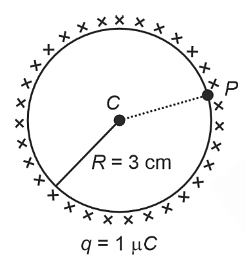Two hollow conducting spheres of radii R1 and R2 (R1 >>R2) have equal charges. The potential would be:
- More on bigger sphere
- More on smaller sphere
- Equal on both the sphere
- Dependent on the material properly of the sphere
The Correct Option is B
Solution and Explanation
When two hollow conducting spheres of radii \( R_1 \) and \( R_2 \) (where \( R_1 \gg R_2 \)) are given equal charges, we need to determine the electric potential on each sphere. The formula for the electric potential \( V \) on the surface of a charged conducting sphere is given by:
\[ V = \frac{kQ}{R} \]
where:
- \( V \) is the electric potential.
- \( k \) is Coulomb's constant.
- \( Q \) is the charge.
- \( R \) is the radius of the sphere.
Since both spheres have the same charge \( Q \), the potential \( V_1 \) on sphere 1 with radius \( R_1 \), and the potential \( V_2 \) on sphere 2 with radius \( R_2 \), are given by:
\[ V_1 = \frac{kQ}{R_1} \]
\[ V_2 = \frac{kQ}{R_2} \]
Given that \( R_1 \gg R_2 \), it follows that:
\[ V_1 = \frac{kQ}{R_1} \] will be significantly smaller than \[ V_2 = \frac{kQ}{R_2} \]
Therefore, the potential is more on the smaller sphere.
Answer: More on smaller sphere.
Top Questions on Electric Potential And Potential Difference
- If a particle of mass 10 mg and charge 2 µC at rest is subjected to a uniform electric field of potential difference 160 V, then the velocity acquired by the particle is
- TS EAMCET - 2025
- Physics
- Electric Potential And Potential Difference
- A thin spherical shell is charged by some source. The potential difference between the two points C and P (in V) shown in the figure is:
(Take \(\frac{1}{4}\pi\epsilon_0 = 9 × 109\)\(\frac{1}{4\pi\epsilon_0}=9\times10^9\) SI units)
- NEET (UG) - 2024
- Physics
- Electric Potential And Potential Difference
- A charge of 10 coulomb is brought from infinity to a point \( P \) near a charged body and in this process 200 joules of work is done. Electric potential at point \( P \) is:
- JEECUP - 2024
- Physics
- Electric Potential And Potential Difference
- Two point charges \( 20 \, \mu C \) and \( -10 \, \mu C \) are separated by a distance of 1 m in air. At what point on the line joining the two charges, the electric potential is zero.
- COMEDK UGET - 2023
- Physics
- Electric Potential And Potential Difference
- Choose correct graph of electric potential for uniformly charged hollow sphere.
- JEE Main - 2023
- Physics
- Electric Potential And Potential Difference
Questions Asked in NEET exam
- A microscope has an objective of focal length \(f_o = 2\) cm and an eyepiece of focal length \(f_e = 4\) cm. The tube length of the microscope is \(L = 40\) cm. If the distance of distinct vision of eye is \(D = 25\) cm, the magnification in the microscope is:
- NEET (UG) - 2025
- Optical Instruments
- Which one of the following is an example of ex-situ conservation?
- NEET (UG) - 2025
- Ex-Situ Conservation
- Which one of the following compounds can exist as cis-trans isomers?
- NEET (UG) - 2025
- Organic Chemistry
- Who proposed that the genetic code for amino acids should be made up of three nucleotides?
- NEET (UG) - 2025
- Molecular Biology
- An electron (mass \(9 \times 10^{-31}\) kg and charge \(1.6 \times 10^{-19}\) C) moving with speed \(c/100\) (\(c\) = speed of light) is injected into a magnetic field of magnitude \(9 \times 10^{-4}\) T perpendicular to its direction of motion. We wish to apply a uniform electric field \( \vec{E} \) together with the magnetic field so that the electron does not deflect from its path. (speed of light \(c = 3 \times 10^8\) m/s):
- NEET (UG) - 2025
- Electric Field
Concepts Used:
Electric Potential
Electric potential is a fundamental concept in physics that helps us understand the behavior of electric charges and the effects of electric fields. It is a scalar quantity that describes the amount of electric potential energy per unit charge at a specific point in space.
The electric potential at a point is defined as the work done per unit charge in bringing a positive test charge from infinity to that point, without accelerating it. It is denoted by the symbol V and is measured in volts (V).
The electric potential is influenced by the presence of electric charges and electric fields. In the vicinity of a positive charge, the electric potential is high, indicating that there is a lot of potential energy associated with the charge. Conversely, in the vicinity of a negative charge, the electric potential is low.
The electric potential can be thought of as a "hill" or "valley" analogy, where charges are like objects that can roll downhill from higher potential (hilltops) to lower potential (valleys). The potential difference between two points, also known as voltage, determines the direction and magnitude of the electric field.
Mathematically, the electric potential can be calculated using the formula V = kQ/r, where k is the electrostatic constant, Q is the charge, and r is the distance from the charge.
Electric potential plays a crucial role in various applications, such as electric circuits, capacitors, and particle accelerators. It helps us analyze and understand the behavior of electric systems and provides a foundation for many areas of electrical engineering and physics.